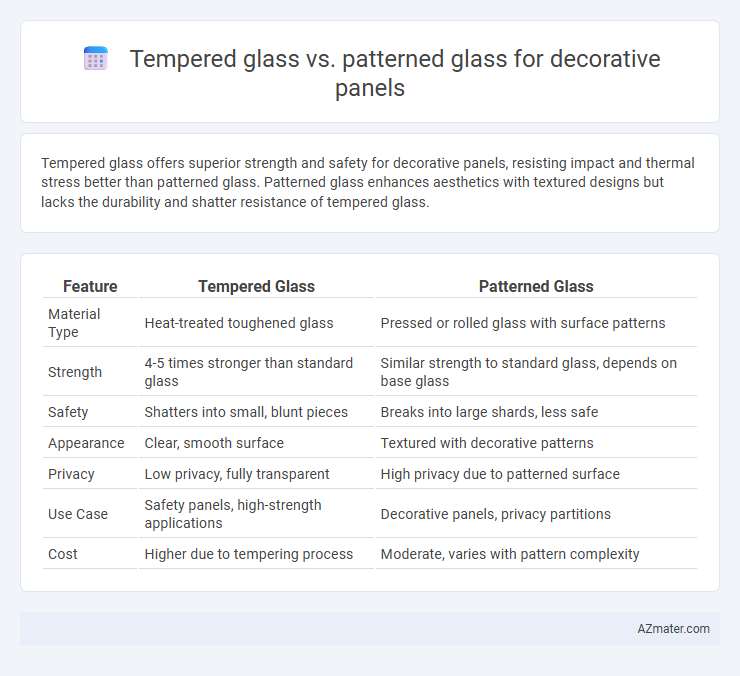Tempered glass offers superior strength and safety for decorative panels, resisting impact and thermal stress better than patterned glass. Patterned glass enhances aesthetics with textured designs but lacks the durability and shatter resistance of tempered glass.
Table of Comparison
| Feature | Tempered Glass | Patterned Glass |
|---|---|---|
| Material Type | Heat-treated toughened glass | Pressed or rolled glass with surface patterns |
| Strength | 4-5 times stronger than standard glass | Similar strength to standard glass, depends on base glass |
| Safety | Shatters into small, blunt pieces | Breaks into large shards, less safe |
| Appearance | Clear, smooth surface | Textured with decorative patterns |
| Privacy | Low privacy, fully transparent | High privacy due to patterned surface |
| Use Case | Safety panels, high-strength applications | Decorative panels, privacy partitions |
| Cost | Higher due to tempering process | Moderate, varies with pattern complexity |
Introduction to Decorative Glass Panels
Tempered glass offers enhanced strength and safety for decorative panels, making it ideal for applications requiring durability and impact resistance. Patterned glass provides unique textures and visual effects, enhancing aesthetic appeal with privacy and light diffusion. Selecting between tempered and patterned glass depends on balancing structural performance with design requirements in decorative glass panel installations.
Overview of Tempered Glass
Tempered glass is a type of safety glass processed through controlled thermal or chemical treatments to increase its strength compared to normal glass. It offers high durability and resistance to impact, making it ideal for decorative panels that require both aesthetic appeal and safety. Its ability to shatter into small, blunt pieces upon breakage ensures enhanced protection in residential and commercial interior applications.
Overview of Patterned Glass
Patterned glass offers unique textures and designs that enhance privacy and diffuse light while adding visual interest to decorative panels. Unlike tempered glass, which emphasizes strength and safety through heat treatment, patterned glass is primarily chosen for its aesthetic qualities and ability to obscure views without sacrificing light transmission. Common patterns include rain, reed, and linen, making it ideal for applications in interior design where both style and functionality are essential.
Aesthetic Appeal: Tempered vs Patterned Glass
Tempered glass offers a sleek, modern aesthetic with a smooth, clear surface that enhances natural light and provides a minimalist appeal, ideal for contemporary decorative panels. Patterned glass adds texture and visual interest through intricate designs or frosted effects, creating depth and privacy while serving as a decorative focal point. Choosing between tempered and patterned glass depends on the desired balance between clarity, texture, and artistic expression in interior design.
Strength and Durability Comparison
Tempered glass offers superior strength due to its heat-treatment process, making it up to five times stronger than standard glass and highly resistant to impact and thermal stress. Patterned glass, while providing aesthetic texture and opacity, generally lacks the enhanced mechanical strength of tempered glass and is more prone to breakage under heavy impact. For decorative panels requiring both durability and safety, tempered glass is the preferred choice due to its exceptional toughness and shatter-resistant properties.
Safety Considerations for Interior Spaces
Tempered glass offers superior safety for decorative panels in interior spaces due to its high strength and shatter-resistant properties, breaking into small, blunt pieces that reduce injury risk. Patterned glass, while aesthetically appealing, often lacks the enhanced strength of tempered glass and can break into sharp shards, posing greater safety hazards. Therefore, tempered glass is the preferred choice for high-traffic areas and environments requiring stringent safety standards.
Customization Options and Design Flexibility
Tempered glass offers extensive customization options including various thicknesses, edge finishes, and the ability to incorporate printed images or digital patterns, enhancing design flexibility for decorative panels. Patterned glass provides unique textures and surface designs that diffuse light and add privacy, with customization options centered on pattern types, densities, and translucency levels. Both materials support tailored aesthetics, but tempered glass excels in strength and visual clarity, while patterned glass emphasizes tactile dimension and diffused visual effects.
Maintenance and Cleaning Differences
Tempered glass offers a smooth, non-porous surface that resists stains and is easy to clean with standard glass cleaners, minimizing maintenance efforts. Patterned glass, due to its textured surface, can trap dust and dirt within grooves, requiring more frequent and detailed cleaning with brushes or specialized tools to maintain clarity. The durability of tempered glass also reduces the risk of scratches during cleaning, whereas patterned glass may show wear more quickly if abrasive methods are used.
Cost Analysis: Tempered vs Patterned Glass
Tempered glass typically costs more than patterned glass due to its heat-treatment process that enhances strength and safety, making it ideal for high-impact areas. Patterned glass offers a more budget-friendly option while providing decorative texture and privacy without the added cost of tempering. When choosing between the two, consider the balance between budget constraints and performance requirements to determine the most cost-effective solution for decorative panels.
Choosing the Right Glass for Decorative Panels
Tempered glass offers superior strength and safety for decorative panels, making it ideal for high-traffic or impact-prone areas due to its shatter-resistant properties. Patterned glass enhances aesthetic appeal by incorporating textures or designs that provide privacy while allowing light diffusion, perfect for stylish and functional interior partitions. Selecting the right glass involves balancing durability needs with visual design goals, where tempered glass ensures robustness and patterned glass contributes uniquely to ambiance and privacy.

Infographic: Tempered glass vs Patterned glass for Decorative panel
 azmater.com
azmater.com